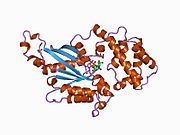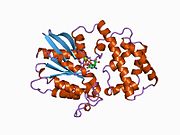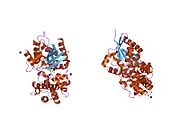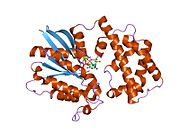GNAI1
Izgled
| edit |
| Guanin nukleotid-vezujući protein (G protein), alfa inhibirajući polipeptid 1 | |||||||||||
|---|---|---|---|---|---|---|---|---|---|---|---|
 PDB prikaz baziran na 1agr. | |||||||||||
| Dostupne strukture | |||||||||||
| 1agr, 1as0, 1as2, 1as3, 1bh2, 1bof, 1cip, 1gdd, 1gfi, 1gg2, 1gia, 1gil, 1git, 1gp2, 1kjy, 1svk, 1svs, 1y3a, 2g83, 2gtp, 2hlb, 2ihb, 2ik8, 2ode | |||||||||||
| Identifikatori | |||||||||||
| Simboli | GNAI1; Gi | ||||||||||
| Vanjski ID | OMIM: 139310 MGI: 95771 HomoloGene: 74417 GeneCards: GNAI1 Gene | ||||||||||
| |||||||||||
| Pregled RNK izražavanja | |||||||||||
 | |||||||||||
| podaci | |||||||||||
| Ortolozi | |||||||||||
| Vrsta | Čovek | Miš | |||||||||
| Entrez | 2770 | 14677 | |||||||||
| Ensembl | ENSG00000127955 | ENSMUSG00000057614 | |||||||||
| UniProt | P63096 | n/a | |||||||||
| RefSeq (mRNA) | NM_002069 | NM_010305 | |||||||||
| RefSeq (protein) | NP_002060 | NP_034435 | |||||||||
| Lokacija (UCSC) | Chr 7: 79.6 - 79.69 Mb | Chr 5: 17.78 - 17.87 Mb | |||||||||
| PubMed pretraga | [1] | [2] | |||||||||
GNAI1, Guanin nukleotid-vezujući protein G(i), alfa-1 podjedinica, je protein koji je kod ljudi kodiran GNAI1 genom.[1][2]
Kliknite na linkove gena, proteina i metabolita da prikažete članke.[3]
Za GNAI1 je bilo pokazano da ostvaruje interakcije sa GPR143,[4] RGS14,[5][6] RIC8A,[7] S1PR1,[8] RGS12[5] i RGS19.[9][10]
- ↑ Bray P, Carter A, Guo V, Puckett C, Kamholz J, Spiegel A, Nirenberg M (August 1987). „Human cDNA clones for an alpha subunit of Gi signal-transduction protein”. Proc Natl Acad Sci U S A 84 (15): 5115–9. DOI:10.1073/pnas.84.15.5115. PMC 298804. PMID 3110783.
- ↑ „Entrez Gene: GNAI1 Guanine nucleotide binding protein (G protein), alpha inhibiting activity polypeptide 1”.
- ↑ The interactive pathway map can be edited at WikiPathways: „NicotineDopaminergic_WP1602”.
- ↑ Schiaffino, M V; d'Addio M, Alloni A, Baschirotto C, Valetti C, Cortese K, Puri C, Bassi M T, Colla C, De Luca M, Tacchetti C, Ballabio A (September 1999). „Ocular albinism: evidence for a defect in an intracellular signal transduction system”. Nat. Genet. (UNITED STATES) 23 (1): 108–12. DOI:10.1038/12715. ISSN 1061-4036. PMID 10471510.
- ↑ 5,0 5,1 Kimple, R J; De Vries L, Tronchère H, Behe C I, Morris R A, Gist Farquhar M, Siderovski D P (August 2001). „RGS12 and RGS14 GoLoco motifs are G alpha(i) interaction sites with guanine nucleotide dissociation inhibitor Activity”. J. Biol. Chem. (United States) 276 (31): 29275–81. DOI:10.1074/jbc.M103208200. ISSN 0021-9258. PMID 11387333.
- ↑ Kimple, Randall J; Kimple Michelle E, Betts Laurie, Sondek John, Siderovski David P (April 2002). „Structural determinants for GoLoco-induced inhibition of nucleotide release by Galpha subunits”. Nature (England) 416 (6883): 878–81. DOI:10.1038/416878a. ISSN 0028-0836. PMID 11976690.
- ↑ Tall, Gregory G; Krumins Andrejs M, Gilman Alfred G (March 2003). „Mammalian Ric-8A (synembryn) is a heterotrimeric Galpha protein guanine nucleotide exchange factor”. J. Biol. Chem. (United States) 278 (10): 8356–62. DOI:10.1074/jbc.M211862200. ISSN 0021-9258. PMID 12509430.
- ↑ Lee, M J; Evans M, Hla T (May 1996). „The inducible G protein-coupled receptor edg-1 signals via the G(i)/mitogen-activated protein kinase pathway”. J. Biol. Chem. (UNITED STATES) 271 (19): 11272–9. DOI:10.1074/jbc.271.19.11272. ISSN 0021-9258. PMID 8626678.
- ↑ Woulfe, D S; Stadel J M (June 1999). „Structural basis for the selectivity of the RGS protein, GAIP, for Galphai family members. Identification of a single amino acid determinant for selective interaction of Galphai subunits with GAIP”. J. Biol. Chem. (UNITED STATES) 274 (25): 17718–24. DOI:10.1074/jbc.274.25.17718. ISSN 0021-9258. PMID 10364213.
- ↑ De Vries, L; Elenko E, Hubler L, Jones T L, Farquhar M G (December 1996). „GAIP is membrane-anchored by palmitoylation and interacts with the activated (GTP-bound) form of G alpha i subunits”. Proc. Natl. Acad. Sci. U.S.A. (UNITED STATES) 93 (26): 15203–8. DOI:10.1073/pnas.93.26.15203. ISSN 0027-8424. PMC 26381. PMID 8986788.
- Sidhu A, Niznik HB (2000). „Coupling of dopamine receptor subtypes to multiple and diverse G proteins.”. Int. J. Dev. Neurosci. 18 (7): 669–77. DOI:10.1016/S0736-5748(00)00033-2. PMID 10978845.
- Brown EJ, Frazier WA (2001). „Integrin-associated protein (CD47) and its ligands.”. Trends Cell Biol. 11 (3): 130–5. DOI:10.1016/S0962-8924(00)01906-1. PMID 11306274.
- Raymond JR, Mukhin YV, Gelasco A, et al. (2002). „Multiplicity of mechanisms of serotonin receptor signal transduction.”. Pharmacol. Ther. 92 (2-3): 179–212. DOI:10.1016/S0163-7258(01)00169-3. PMID 11916537.
- Jiang M, Pandey S, Tran VT, Fong HK (1991). „Guanine nucleotide-binding regulatory proteins in retinal pigment epithelial cells.”. Proc. Natl. Acad. Sci. U.S.A. 88 (9): 3907–11. DOI:10.1073/pnas.88.9.3907. PMC 51562. PMID 1902575.
- Gennity JM, Siess W (1991). „Thrombin inhibits the pertussis-toxin-dependent ADP-ribosylation of a novel soluble Gi-protein in human platelets.”. Biochem. J. 279 ( Pt 3): 643–50. PMC 1151493. PMID 1953657.
- Itoh H, Toyama R, Kozasa T, et al. (1988). „Presence of three distinct molecular species of Gi protein alpha subunit. Structure of rat cDNAs and human genomic DNAs.”. J. Biol. Chem. 263 (14): 6656–64. PMID 2834384.
- Bloch DB, Bloch KD, Iannuzzi M, et al. (1988). „The gene for the alpha i1 subunit of human guanine nucleotide binding protein maps near the cystic fibrosis locus.”. Am. J. Hum. Genet. 42 (6): 884–8. PMC 1715192. PMID 3130752.
- Nagata K, Katada T, Tohkin M, et al. (1988). „GTP-binding proteins in human platelet membranes serving as the specific substrate of islet-activating protein, pertussis toxin.”. FEBS Lett. 237 (1-2): 113–7. DOI:10.1016/0014-5793(88)80182-0. PMID 3139448.
- Kagimoto S, Yamada Y, Kubota A, et al. (1994). „Human somatostatin receptor, SSTR2, is coupled to adenylyl cyclase in the presence of Gi alpha 1 protein.”. Biochem. Biophys. Res. Commun. 202 (2): 1188–95. DOI:10.1006/bbrc.1994.2054. PMID 7914078.
- Nitta K, Uchida K, Kawashima A, et al. (1994). „Identification of GTP-binding proteins in human glomeruli.”. Nippon Jinzo Gakkai shi 36 (1): 9–12. PMID 8107314.
- Law SF, Zaina S, Sweet R, et al. (1994). „Gi alpha 1 selectively couples somatostatin receptor subtype 3 to adenylyl cyclase: identification of the functional domains of this alpha subunit necessary for mediating the inhibition by somatostatin of cAMP formation.”. Mol. Pharmacol. 45 (4): 587–90. PMID 8183236.
- Europe-Finner GN, Phaneuf S, Watson SP, López Bernal A (1993). „Identification and expression of G-proteins in human myometrium: up-regulation of G alpha s in pregnancy.”. Endocrinology 132 (6): 2484–90. DOI:10.1210/en.132.6.2484. PMID 8504751.
- Laugwitz KL, Allgeier A, Offermanns S, et al. (1996). „The human thyrotropin receptor: a heptahelical receptor capable of stimulating members of all four G protein families.”. Proc. Natl. Acad. Sci. U.S.A. 93 (1): 116–20. DOI:10.1073/pnas.93.1.116. PMC 40189. PMID 8552586.
- Andersson B, Wentland MA, Ricafrente JY, et al. (1996). „A "double adaptor" method for improved shotgun library construction.”. Anal. Biochem. 236 (1): 107–13. DOI:10.1006/abio.1996.0138. PMID 8619474.
- Lee MJ, Evans M, Hla T (1996). „The inducible G protein-coupled receptor edg-1 signals via the G(i)/mitogen-activated protein kinase pathway.”. J. Biol. Chem. 271 (19): 11272–9. DOI:10.1074/jbc.271.19.11272. PMID 8626678.
- De Vries L, Elenko E, Hubler L, et al. (1997). „GAIP is membrane-anchored by palmitoylation and interacts with the activated (GTP-bound) form of G alpha i subunits.”. Proc. Natl. Acad. Sci. U.S.A. 93 (26): 15203–8. DOI:10.1073/pnas.93.26.15203. PMC 26381. PMID 8986788.
- Yu W, Andersson B, Worley KC, et al. (1997). „Large-scale concatenation cDNA sequencing.”. Genome Res. 7 (4): 353–8. PMC 139146. PMID 9110174.
- Popov S, Yu K, Kozasa T, Wilkie TM (1997). „The regulators of G protein signaling (RGS) domains of RGS4, RGS10, and GAIP retain GTPase activating protein activity in vitro.”. Proc. Natl. Acad. Sci. U.S.A. 94 (14): 7216–20. DOI:10.1073/pnas.94.14.7216. PMC 23796. PMID 9207071.
- Shuey DJ, Betty M, Jones PG, et al. (1998). „RGS7 attenuates signal transduction through the G(alpha q) family of heterotrimeric G proteins in mammalian cells.”. J. Neurochem. 70 (5): 1964–72. DOI:10.1046/j.1471-4159.1998.70051964.x. PMID 9572280.

























